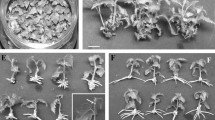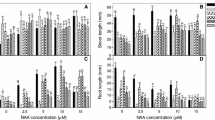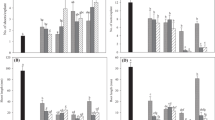Abstract
Aloe species are valuable plants with great ornamental and medicinal value. Although micropropagation protocols have been developed to meet the increasing global demand, the effects of the series of events during micropropagation on the phytochemical and pharmacological efficacy of ex-vitro plants remains poorly understood. Thus, we evaluated the effects of cytokinin and rooting compounds used during the shoot regeneration and rooting phases respectively, on secondary metabolite production in greenhouse-grown in vitro-derived Aloe arborescens. Shoots derived from meta-methoxytopolin (MemT)-containing medium and rooted with either smoke–water (SW) or indole butyric acid (IBA) had higher levels of total phenolics and flavonoids than those rooted on plant growth regulator (PGR)-free medium. Iridoid content was significantly reduced in cytokinin-regenerated shoots rooted with IBA in comparison to PGR-free regenerated shoots rooted with IBA. Conversely, the use of SW for rooting in cytokinin-regenerated shoots significantly increased iridoid content when compared to PGR-free regenerated shoots rooted with SW. These findings suggest an antagonistic interaction between cytokinins used in this study and IBA as well as a possible synergistic or additive interaction of the cytokinins with SW on iridoid production. Significantly higher antioxidant activity was recorded in shoots regenerated from meta-topolin riboside (mTR) and MemT and rooted with IBA or SW when compared to those rooted without PGR. Overall, the type of cytokinin and rooting treatments individually and interactively had a significant carry-over effect on secondary metabolite production and antioxidant potential of tissue culture-derived A. arborescens. Therefore, when micropropagating plants for medicinal uses, it is prudent to select the right cytokinin and rooting compound for optimal production of secondary metabolites and ultimately the pharmacological efficacy of acclimatized plants.




Similar content being viewed by others
Abbreviations
- AE:
-
Aucubin equivalents
- ANOVA:
-
Analysis of variance
- BA:
-
6-Benzyladenine
- BAR:
-
Benzyladenine riboside
- BHT:
-
Butylated hydroxytoluene
- CCE:
-
Cyanide chloride equivalents
- CE:
-
Catechin equivalents
- DMRT:
-
Duncan’s Multiple Range Test
- DPPH:
-
2,2-Diphenyl-1-picryl hydrazyl
- DW:
-
Dry weight
- GAE:
-
Gallic acid equivalents
- IBA:
-
Indole butyric acid
- MemT:
-
meta-Methoxytopolin
- MemTR:
-
meta-Methoxytopolin riboside
- MemTTHP:
-
meta-Methoxytopolin tetrahydropyran-2-yl
- MS:
-
Murashige and Skoog (1962)
- mT:
-
meta-Topolin
- mTR:
-
meta-Topolin riboside
- PGR:
-
Plant growth regulator
- PGRs:
-
Plant growth regulators
- SW:
-
Smoke–water
References
Amarowicz R, Pegg RB, Rahimi-Moghaddam P, Barl B, Weil JA (2004) Free-radical scavenging capacity and antioxidant activity of selected plant species from the Canadian prairies. Food Chem 84:551–562
Amoo SO, Van Staden J (2012) Influence of plant growth regulators on shoot proliferation and secondary metabolite production in micropropagated Huernia hystrix. Plant Cell Tissue Organ Cult. doi:10.1007/s11240-11012-10230-x
Amoo SO, Aremu AO, Van Staden J (2012) In vitro plant regeneration, secondary metabolite production and antioxidant activity of micropropagated Aloe arborescens Mill. Plant Cell Tissue Organ Cult 111:345–358
Aremu AO, Bairu MW, Szücová L, Doležal K, Finnie JF, Van Staden J (2012a) Assessment of the role of meta-topolins on in vitro produced phenolics and acclimatization competence of micropropagated ‘Williams’ banana. Acta Physiol Plant doi. doi:10.1007/s11738-012-1027-6
Aremu AO, Bairu MW, Finnie JF, Van Staden J (2012b) Stimulatory role of smoke–water and karrikinolide on the photosynthetic pigment and phenolic contents of micropropagated ‘Williams’ bananas. Plant Growth Regul 67:271–279
Chiwocha SDS, Dixon KW, Flematti GR, Ghisalberti EL, Merritt DJ, Nelson DC, Riseborough J-AM, Smith SM, Stevens JC (2009) Karrikins: a new family of plant growth regulators in smoke. Plant Sci 177:252–256
Collin HA (2001) Secondary product formation in plant tissue cultures. Plant Growth Regul 34:119–134
Coste A, Vlase L, Halmagyi A, Deliu C, Coldea G (2011) Effects of plant growth regulators and elicitors on production of secondary metabolites in shoot cultures of Hypericum hirsutum and Hypericum maculatum. Plant Cell Tissue Organ Cult 106:279–288
Dixon RA (2001) Natural products and plant disease resistance. Nature 411:843–847
Dörnenburg H, Knorr D (1995) Strategies for the improvement of secondary metabolite production in plant cell cultures. Enzyme Microb Technol 17:674–684
Fawole OA, Ndhlala AR, Amoo SO, Finnie JF, Van Staden J (2009) Anti-inflammatory and phytochemical properties of twelve medicinal plants used for treating gastro-intestinal ailments in South Africa. J Ethnopharmacol 123:237–243
Fawole OA, Amoo SO, Ndhlala AR, Light ME, Finnie JF, Van Staden J (2010) Anti-inflammatory, anticholinesterase, antioxidant and phytochemical properties of medicinal plants used for pain-related ailments in South Africa. J Ethnopharmacol 127:235–241
Gobbo-Neto L, Lopes NP (2007) Medicinal plants: factors of influence on the content of secondary metabolites. Quím Nova 30:374–381
Grace OM (2011) Current perspectives on the economic botany of the genus Aloe L. (Xanthorrhoeaceae). S Afr J Bot 77:980–987
Grace OM, Simmonds MSJ, Smith GF, Van Wyk AE (2008) Therapeutic uses of Aloe L. (Asphodelaceae) in southern Africa. J Ethnopharmacol 119:604–614
Huang D, Ou B, Prior RL (2005) The chemistry behind antioxidant capacity assays. J Agric Food Chem 53:1841–1856
Karioti A, Hadjipavlou-Litina D, Mensah MLK, Fleischer TC, Saltsa H (2004) Composition and antioxidant activity of the essential oils of Xylopia aethiopica (Dun) A. Rich. (Annonaceae) leaves, stem bark, root bark, and fresh and dried fruits, growing in Ghana. J Agric Food Chem 52:8094–8098
Levieille G, Wilson G (2002) In vitro propagation and iridoid analysis of the medicinal species Harpagophytum procumbens and H. zeyheri. Plant Cell Rep 21:220–225
Liu X-N, Zhang X-Q, Sun J-S (2007) Effects of cytokinins and elicitors on the production of hypericins and hyperforin metabolites in Hypericum sampsonii and Hypericum perforatum. Plant Growth Regul 53:207–214
Makkar HPS (2000) Quantification of tannins in tree foliage: a laboratory manual for the FAO/IAEA co-ordinated research project on “Use of nuclear and related techniques to develop simple tannin assays for predicting and improving the safety and efficiency of feeding ruminants on tanniniferous tree foliage”. Joint FAO/IAEA Division of Nuclear Techniques in Food and Agriculture, Vienna
Malik S, Sharma N, Sharma UK, Singh NP, Bhushan S, Sharma M, Sinha AK, Ahuja PS (2010) Qualitative and quantitative analysis of anthraquinone derivatives in rhizomes of tissue culture-raised Rheum emodi Wall. plants. J Plant Physiol 167:749–756
Man S, Wang J, Gao W, Guo S, Li Y, Zhang L, **ao P (2013) Chemical analysis and anti-inflammatory comparison of the cell culture of Glycyrrhiza with its field cultivated variety. Food Chem 136:513–517
Martínez-Bonfil B, Salcedo-Morales G, López-Laredo A, Ventura-Zapata E, Evangelista-Lozano S, Trejo-Tapia G (2011) Shoot regeneration and determination of iridoid levels in the medicinal plant Castilleja tenuiflora Benth. Plant Cell Tissue Organ Cult 107:195–203
Matkowski A (2008) Plant in vitro culture for the production of antioxidants—a review. Biotechnol Adv 26:548–560
Moyo M, Bairu MW, Amoo SO, Van Staden J (2011) Plant biotechnology in South Africa: micropropagation research endeavours, prospects and challenges. S Afr J Bot 77:996–1011
Murashige T, Skoog F (1962) A revised medium for rapid growth and bio assays with tobacco tissue cultures. Physiol Plant 15:473–497
Oksman-Caldentey K-M, Inzé D (2004) Plant cell factories in the post-genomic era: new ways to produce designer secondary metabolites. Trends Plant Sci 9:433–440
Pavarini DP, Pavarini SP, Niehues M, Lopes NP (2012) Exogenous influences on plant secondary metabolite levels. Anim Feed Sci Technol 176:5–16
Sakakibara H, Takei K, Hirose N (2006) Interactions between nitrogen and cytokinin in the regulation of metabolism and development. Trends Plant Sci 11:440–448
Sood H, Chauhan R (2010) Biosynthesis and accumulation of a medicinal compound, Picroside-I, in cultures of Picrorhiza kurroa Royle ex Benth. Plant Cell Tissue Organ Cult 100:113–117
Soós V, Sebestyén E, Juhász A, Szalai G, Tandori J, Light ME, Kohout L, Van Staden J, Balázs E (2010) Transcriptome analysis of germinating maize kernels exposed to smoke-water and the active compound KAR1. BMC Plant Biol 10:236
Verpoorte R, Memelink J (2002) Engineering secondary metabolite production in plants. Curr Opin Biotechnol 13:181–187
Verpoorte R, Contin A, Memelink J (2002) Biotechnology for the production of plant secondary metabolites. Phytochem Rev 1:13–25
Zhishen J, Mengcheng T, Jianming W (1999) The determination of flavonoid contents in mulberry and their scavenging effects on superoxide radicals. Food Chem 64:555–559
Zhou J, Van Staden J, Guo LP, Huang LQ (2011) Smoke-water improves shoot growth and indigo accumulation in shoots of Isatis indigotica seedlings. S Afr J Bot 77:787–789
Zielińska S, Piątczak E, Kalemba D, Matkowski A (2011) Influence of plant growth regulators on volatiles produced by in vitro grown shoots of Agastache rugosa (Fischer & C. A. Meyer) O. Kuntze. Plant Cell Tissue Organ Cult 107:161–167
Acknowledgments
The first author was supported by a Claude Leon Foundation Postdoctoral Fellowship. We thank the Laboratory of Growth Regulators, Palacký University and Institute of Experimental Botany AS CR, Czech Republic for the topolins. Financial support from the NRF/China Collaborative Programme is greatly appreciated.
Author information
Authors and Affiliations
Corresponding author
Rights and permissions
About this article
Cite this article
Amoo, S.O., Aremu, A.O. & Van Staden, J. Shoot proliferation and rooting treatments influence secondary metabolite production and antioxidant activity in tissue culture-derived Aloe arborescens grown ex vitro. Plant Growth Regul 70, 115–122 (2013). https://doi.org/10.1007/s10725-013-9783-x
Received:
Accepted:
Published:
Issue Date:
DOI: https://doi.org/10.1007/s10725-013-9783-x




